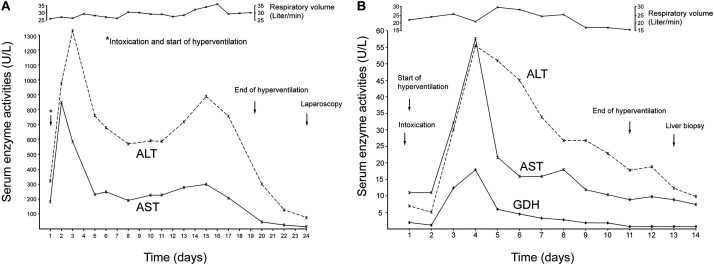Fig. 3. (A) Serum activities of AST and ALT after intoxication by ingested chloroform.
The patient (case 4 in Table 2) was a house painter and had stored chloroform in a beer bottle, from which he erroneously ingested 50 mL chloroform. Prior to intoxication, he had drank 1.5 L beer contained in other beer bottles. Narcosis requiring endotracheal intubation for gastrointestinal lavage and short-term artificial ventilation. The CO2-induced hyperventilation was started 6 hours after ingestion, whereby a respiratory volume between 24 and 34 Liter min-1 was achieved as shown at the top of the figure. Via a nasal tube, CO2 was provided at a flow rate of 3 to 6 Liter min−1. Blood showed pH that was between 7.36 and 7.46, PO2 between 83 and 110 mmHg, PCO2 between 35 and 55, and HCO3 between 21 and 31, and respiratory frequency between 15 and 30 min−1. The therapy using hyperventilation was well tolerated by the cooperative patient and had to be extended for 19 days because serum activities of AST and ALT declined slowly. Serum activities of liver enzymes showed two peaks. On day 2, AST was 850 U/L and ALT was 1330 U/L on day 3. Both enzymes declined and had a second peak on day 15, with AST of 300 U/L and ALT of 890 U/L. Total bilirubin was in a range between 0.8 and 2.1 mg/dL. Hemoglobin was between 11.8 and 15.5, erythrocytes between 3800 and 4800, leucocytes between 5.100 and 11500. Serum creatinine remained in the normal range, considering that forced diuresis was provided for prophylactic reasons. Liver biopsy obtained at laparoscopy on day 24 revealed a striking proliferation of stellate cells, no fatty changes of the hepatocytes, and no necrosis by light microscopy. (B) Serum activities of AST, ALT, and GDH after intoxication by ingested CCl4. The patient (case 6 in Table 2) intentionally swallowed 30 mL CCl4, vomited twice, and received a gastrointestinal lavage. CO2-induced hyperventilation was started 9 hours after intoxication and continued for 11 days. CO2 was applied via a nasal tube at a flow rate of 2–4 Liter min−1 and resulted in a respiratory volume of up to 30 Liter min−1, as shown on the top of the figure. CO2 was given at a flow rate between 3.5 and 5.0 Liter min−1 that resulted in a respiratory frequency ranging from 28 to 36 per minute. Blood showed pH of 7.31 to 7.33, PO2 of around 111, HCO3 of around 21.3, and PCO2 of around 43.9. On day 3 after intoxication, serum activities of liver enzymes increased and reached a maximum on day 4 (AST of 59 U/L, ALT of 56 U/L, GDH of 18 U/L) and normalized during the next days until day 14 after intoxication. Other laboratory test were in the normal range, except leucocytes (at 14400). Liver biopsy on day 13 showed no abnormalities. The patient was discharged on day 15.
Abbreviations: ALT, alanine transaminase; AST, aspartate transaminase; CCl4, carbon tetrachloride; GDH, glutamate dehydrogenase.

